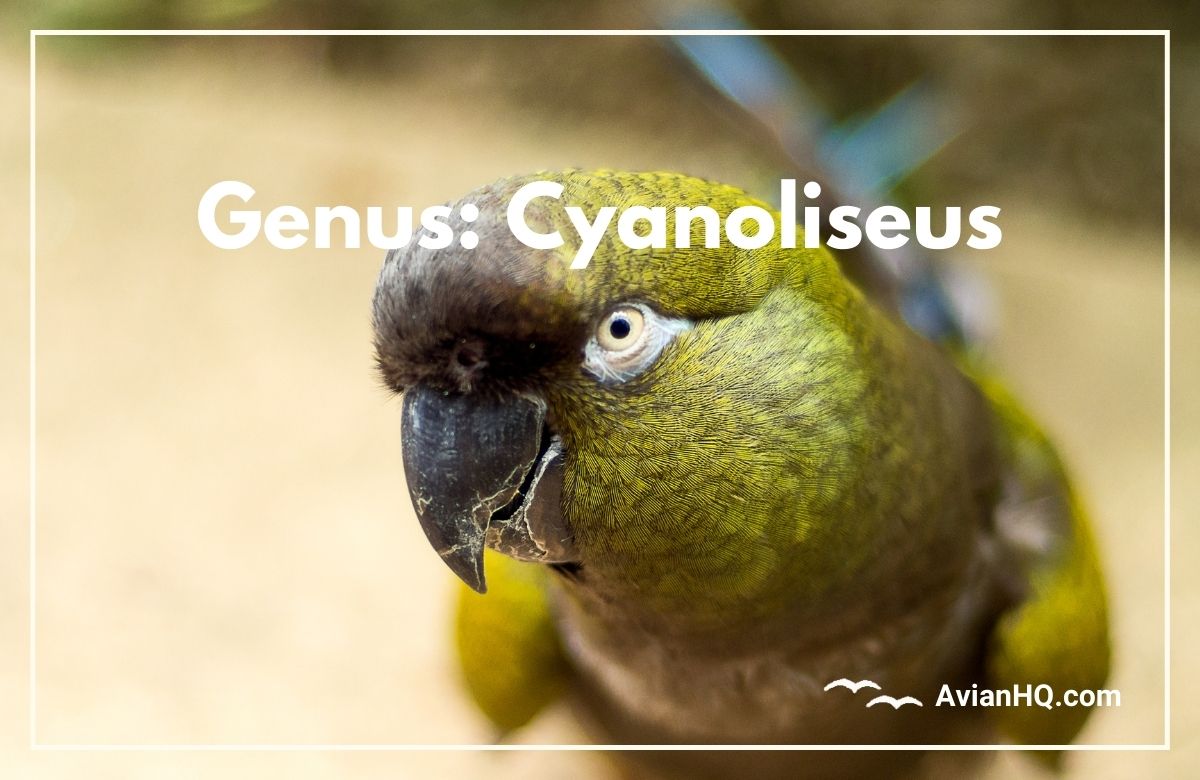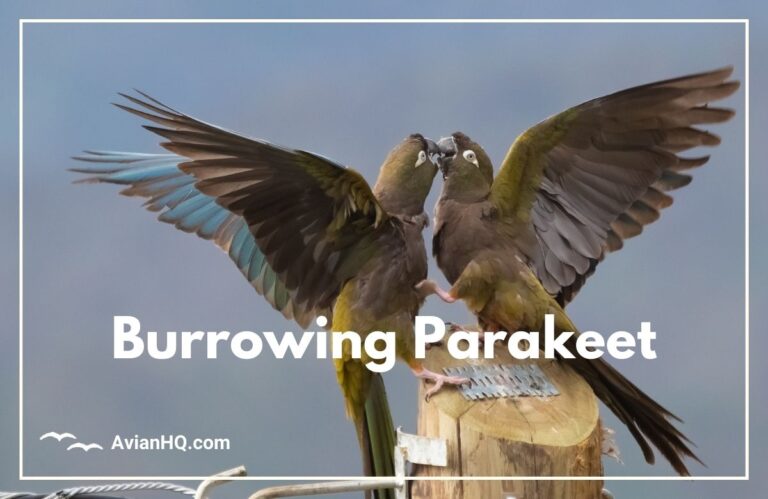Genus: Cyanoliseus
Parrots and parakeets are some of the most intelligent and charismatic birds in the world. Over 350 species exist, span a rainbow of bright colors, and showcase interesting behaviors that reflect their abilities. One special genus of parakeets is Cyanoliseus, consisting of large, long tailed species that inhabit South America.
“Cyanoliseus parakeets are highly intelligent birds that exhibit complex behaviors.”
There is currently only one living species within the Cyanoliseus genus, though evidence exists that other species previously existed. The single surviving member of this genus is the Burrowing Parakeet (Cyanoliseus patagonus), an endangered parrot of the Patagonian region in Chile and Argentina. While more Cyanoliseus species likely roamed these areas long ago, the Burrowing Parakeet serves as the last remaining example of parrots within this group.
The Burrowing Parrot exhibits many characteristics unique to the Cyanoliseus genus. Let’s explore what defines this remarkable group of parrots, spotlight the sole surviving member, and learn what threats Cyanoliseus species face today. Through education and conservation action, we can preserve the legacy of this highly intelligent genus of parakeets.
Species Spotlights
Burrowing Parakeet (Cyanoliseus patagonus)
Also known as the Patagonian Conure, the Burrowing Parakeet or Burrowing Parrot is the only surviving member of the Cyanoliseus genus. This large parakeet measures 30-38 centimeters (12-15 inches) long and bears vivid green plumage accented by a grayish crown and blue flight feathers. Its scientific name comes from its bluish wings (cyan) and smooth feather texture (liseus).
The Burrowing Parakeet inhabits open grasslands, scrublands, and forest edges ranging across southeastern South America. Its native range spans parts of southern Brazil, Uruguay, Paraguay, Bolivia, Chile and southwestern Argentina. These intelligent birds travel in noisy flocks, nest in burrows or tree cavities, and utilize their strong jaws to feed on seeds, nuts, fruits, buds, and some insects.
As the sole remaining Cyanoliseus species, the Burrowing Parakeet serves as an important “poster bird” for conservation. While not currently endangered, it faces threats from habitat loss and trapping for the pet trade. Protecting grassland ecosystems and regulating capture will help preserve populations of this unique parakeet into the future.
Other Cyanoliseus Species
While the Burrowing Parakeet remains the only living member of the Cyanoliseus genus, studies show that up to 3 other species may have existed prehistorically. Based on genetic evidence and some fossil data, scientists have proposed there were formerly Cyanoliseus species in the Caribbean, the Andean region, and southern South America respectively.
“Up to 3 extinct Cyanoliseus species likely existed before modern times.”
Due to factors like climate shifts or human activity, these hypothetical Cyanoliseus species all faced extinction prior to recent history. As a result, the Burrowing Parakeet persists as the sole surviving example of these specialized parakeets. By protecting this species and its grassland habitat, we pay respect to its potentially lost evolutionary cousins within the Cyanoliseus genus.
Behavior and Intelligence
The Burrowing Parakeet exhibits many complex behaviors reflecting advanced intelligence for a bird. All parrots display brighter than average bird brains, but Cyanoliseus species seem exceptionally smart, social and communicative.
Communication
Burrowing Parakeets have a repertoire of contact calls, alarm calls, and flight calls used to maintain group cohesion. Their loud squawks of “ri-ka-tek!” ring out as they fly in large flocks or roost communally in trees. Researchers have identified over a dozen distinct vocalizations from these highly social birds.
Bonding and Breeding
These parakeets are monogamous breeders that mate for life. Paired couples synchronize actions closely as they prepare nests together in burrows or tree cavities. Both parents share brooding and feeding duties once their 4-6 eggs hatch after about 26 days of incubation. The bonded pairs preen each other often and may refuse other mates if one dies.
Foraging and Feeding
Burrowing parakeets have strong jaws and beaks evolved to crack hard nuts and seeds. They display intelligence seeking the most energy-rich foods across grasslands and forests. Their range of dietary items also speaks to behavioral flexibility. As the saying goes, “many crops, one stomach!”
Captivity and Training
An early 20th century psychologist studied captive Burrowing Parakeets completing color and shape matching tasks. He concluded they matched simians in intelligence, outperforming dogs. Today, pet Burrowing Parakeets are noted as playful, curious companions open to bonding, learning tricks and communicating. Their intelligence makes them highly responsive to patient training.
Overall the behavioral richness of the Burrowing Parakeet provides a window into the former diversity of Cyanoliseus species before extinction. Protecting this species allows continued study of its advanced intelligence within the parrot family.
Cultural Significance
The vibrant green plumage and social behaviors of Burrowing Parakeets have attracted human attention across the ages. Indigenous peoples, pet owners, conservationists and pop culture fans have all found significance in these brilliant birds.
“Burrowing Parakeets have drawn appreciation across cultures over time.”
Native Traditions
Some native peoples like the Mapuche people harvested Burrowing Parakeet feathers or kept them as pets. Certain ceremonial instruments and headdresses incorporated the green plumes. These early relationships reflected respect and admiration rather than overexploitation.
Pet Trade and Aviculture
The pet trade prizes Burrowing Parakeets for their stunning colors, playfulness and longevity. Demand accelerated in the 1980s and 1990s to the point of overcollection and export restrictions by 1992. Since then monitoring helps balance captive breeding and sustainable harvesting from the wild population of over 1 million birds.
Media and Pop Culture
Bright green parakeets hold broad cultural appeal and pop up in movies, logos, commercials and more. For example, the Paraguay national football team is nicknamed “Los Guaraníes” after the Guarani word for these birds. Parakeet motifs also appear on consumer products, albums, events and businesses across South America.
While too much commercial use risks trivialization, such cultural tributes help raise awareness. When grounded in genuine appreciation and conservation ethics, the prominence of Burrowing Parakeets in human society ultimately benefits the species.
Threats and Conservation
Although still relatively abundant across roughly 1.5 million square kilometers (579,000 square miles) of South America, the sole surviving Burrowing Parakeet faces an uncertain future without continued conservation efforts.
Habitat Loss
Conversion of native grasslands and scrublands to agriculture threatens the specialized ecosystems this species depends on. For example, their population stronghold in the Llanos grasslands of Argentina, Paraguay and Bolivia continues to decline at an estimated 1-5% annually.
Trapping and Trade
Live capture of up to 8000 Burrowing Parakeets per year also pressures some wild populations, despite export quotas meant to limit trapping. While no universal bans exist yet, both Argentina and Paraguay have implemented restrictions.
Conservation Status
Given declining habitat and trade threats, the IUCN Red List classifies the Burrowing Parakeet as Near Threatened but with an ongoing decreasing population trend overall. Without intervention, endangered status could loom.
Protecting Grasslands
Preserving native grasslands and savannas tops the conservation agenda for Burrowing Parakeets since they have adapted closely to these ecosystems. Responsible grazing plans and guarded protected areas will benefit these birds.
In the end, cultural esteem for the Burrowing Parakeet must translate into habitat and species protections. Wise conservation policies can keep Cyanoliseus species vibrant in the wild while also nurturing captive populations.
Conclusion
The brilliant green Burrowing Parakeets of the Cyanoliseus genus make up a one-of-a-kind group of intelligent parrots. As the sole surviving member of this lineage, the Burrowing Parakeet carries the legacy of its extinct evolutionary cousins into the present day.
Despite near threatened status and decreasing populations, hope remains to conserve this singular parakeet. Through habitat protections, sustainable trade policies and responsible captive breeding programs, the vivid forests of green feathers can continue gracing South America’s skies for generations to come.
“As stewards of biodiversity, we must ensure Cyanoliseus species persists into the future”
Beyond mere conservation, these rare parakeets deserve appreciation and admiration in human culture. Their advanced social behaviors, communication abilities and captive trainability showcase complex cognitive gifts. By supporting both environmental and ethical stewardship for endangered species like Burrowing Parakeets, we can sustain beings that enrich our world immensely.
Our descendants would never forgive us if they lost the chance to marvel at these remarkable feathers and behaviors just a generation or two from now. Any encounter with a Cyanoliseus parakeet proves itself unforgettable.


